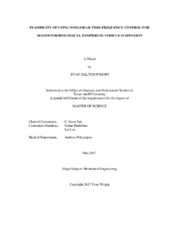| dc.contributor.advisor | Suh, Chii-Der | |
| dc.creator | Wright, Evan Dalton | |
| dc.date.accessioned | 2019-03-07T15:44:13Z | |
| dc.date.available | 2019-05-01T06:09:20Z | |
| dc.date.created | 2017-05 | |
| dc.date.issued | 2017-03-31 | |
| dc.date.submitted | May 2017 | |
| dc.identifier.uri | https://hdl.handle.net/1969.1/174890 | |
| dc.description.abstract | Semi-active vehicle suspensions that use magnetorheological (MR) dampers are able to better dissipate vibrations compared to conventional dampers because of their controllable damping characteristics. The performance of current MR damper control methods is often hindered by incorrect assumptions and linearized models. Therefore, a need exists to design an adaptive controller with improved accuracy and reliability. The objective of this research is to design an improved controller for MR dampers in vehicle suspension using the nonlinear time-frequency control approach and evaluate its feasibility by numerically employing MATLAB Simulink. Simulations in this research are performed using a simplified quarter car suspension model and modified Bouc-Wen damper model. The proposed control method is evaluated based on its ability to reduce the amplitude of vibrations and minimize acceleration of the car body for various test cases. Simulations are also performed using the skyhook controller and passive suspension to assess the performance of the proposed controller.
The results of the simulations show that the proposed nonlinear time-frequency controller can successfully be applied to an MR damper suspensions system for vibration control. The proposed controller outperforms the skyhook controller in terms of reducing acceleration of the car body in each of the tested scenarios. The proposed controller also shows the ability to more efficiently manage the current input to the system. In general, the skyhook controller gives more improved vibration amplitude responses but is prone to generate large spikes in car body acceleration at higher frequency road profile inputs. Simulations performed with the passive system show large displacement amplitudes and inability to prevent oscillation. The feed-forward aspect and adaptive nature of the proposed controller gives it the ability to better compensate for the time-delay in the operation of the MR damper. The proposed controller shows sensitivity to controller parameters when pursuing the best response for different road profile input cases. | en |
| dc.format.mimetype | application/pdf | |
| dc.language.iso | en | |
| dc.subject | magnetorheological damper | en |
| dc.subject | semi-active vibration control | en |
| dc.title | Feasibility of Using Nonlinear Time-Frequency Control for Magnetorheological Dampers in Vehicle Suspension | en |
| dc.type | Thesis | en |
| thesis.degree.department | Mechanical Engineering | en |
| thesis.degree.discipline | Mechanical Engineering | en |
| thesis.degree.grantor | Texas A & M University | en |
| thesis.degree.name | Master of Science | en |
| thesis.degree.level | Masters | en |
| dc.contributor.committeeMember | Lau, Sai | |
| dc.contributor.committeeMember | Hurlebaus, Stefan | |
| dc.type.material | text | en |
| dc.date.updated | 2019-03-07T15:44:13Z | |
| local.embargo.terms | 2019-05-01 | |
| local.etdauthor.orcid | 0000-0002-2862-8188 | |


